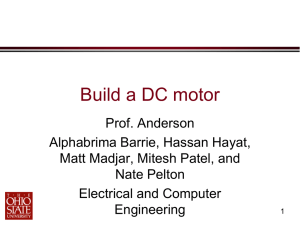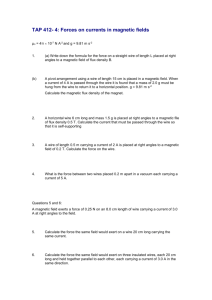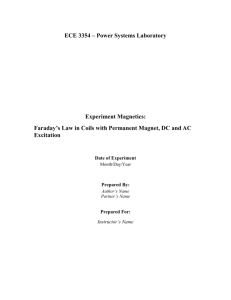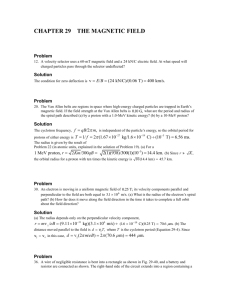Faraday and Lenz`s Law - Galileo
advertisement
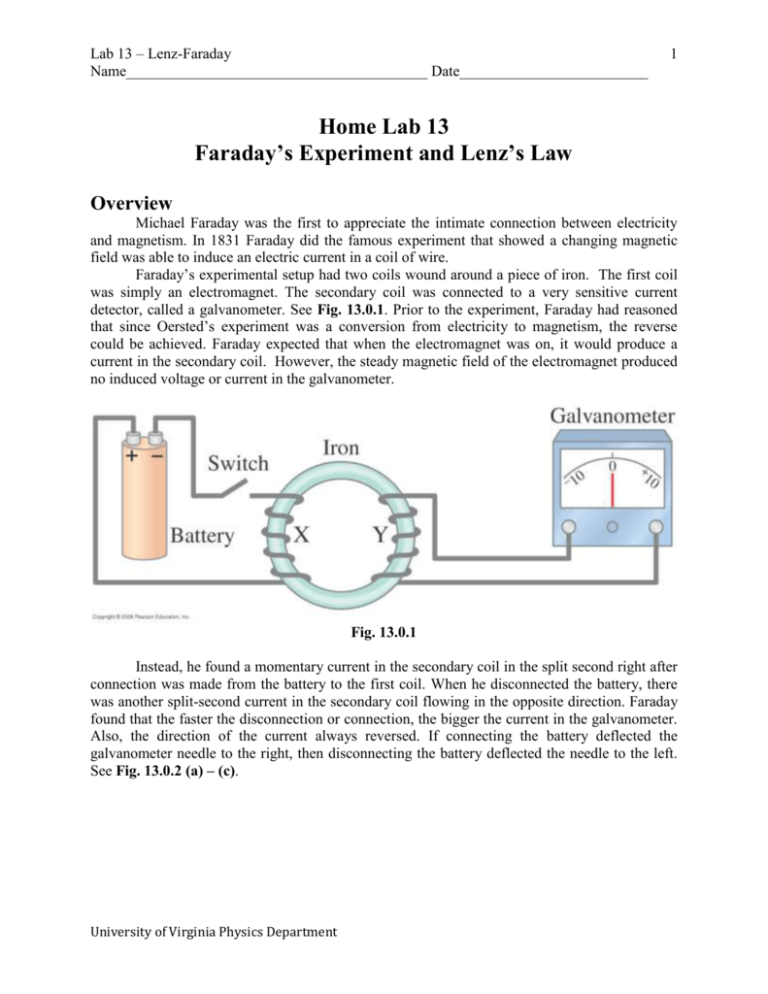
Lab 13 – Lenz-Faraday Name________________________________________ Date_________________________ 1 Home Lab 13 Faraday’s Experiment and Lenz’s Law Overview Michael Faraday was the first to appreciate the intimate connection between electricity and magnetism. In 1831 Faraday did the famous experiment that showed a changing magnetic field was able to induce an electric current in a coil of wire. Faraday’s experimental setup had two coils wound around a piece of iron. The first coil was simply an electromagnet. The secondary coil was connected to a very sensitive current detector, called a galvanometer. See Fig. 13.0.1. Prior to the experiment, Faraday had reasoned that since Oersted’s experiment was a conversion from electricity to magnetism, the reverse could be achieved. Faraday expected that when the electromagnet was on, it would produce a current in the secondary coil. However, the steady magnetic field of the electromagnet produced no induced voltage or current in the galvanometer. Fig. 13.0.1 Instead, he found a momentary current in the secondary coil in the split second right after connection was made from the battery to the first coil. When he disconnected the battery, there was another split-second current in the secondary coil flowing in the opposite direction. Faraday found that the faster the disconnection or connection, the bigger the current in the galvanometer. Also, the direction of the current always reversed. If connecting the battery deflected the galvanometer needle to the right, then disconnecting the battery deflected the needle to the left. See Fig. 13.0.2 (a) – (c). University of Virginia Physics Department Lab 13 – Lenz-Faraday Name________________________________________ Date_________________________ 2 Fig. 13.0.2 (a) Fig. 13.0.2 (b) Fig. 13.0.2 (c) Lenz generalized Faraday’s experimental observation as follows: the induced voltage or current will always give rise to a magnetic field that opposes the change that produced it. The overall effect will be similar to friction – no matter in what direction the object moves, friction always opposes the motion. See Fig. 13.0.4. This phenomenon is the basis of magnetic braking, which we will cover in activity 3. University of Virginia Physics Department Lab 13 – Lenz-Faraday Name________________________________________ Date_________________________ 3 Fig. 13.0.4 Faraday’s Experiment is monumental in the history of physics. It completed the missing link converting magnetism into electricity, and opened up a new world where radios, cell phones, generators, and household consumption of electricity became possible. A century after Faraday, the same experiment inspired Einstein to develop special relativity to account for paradoxical observations of Faraday’s Experiment in different reference frames. In a word, Faraday’s Experiment is like the proverbial golden goose, and it should be introduced to physics students in a way that preserves its historical significance. An excellent JAVA applet that illustrates the effect of moving a magnet near a coil can be found at http://phet.colorado.edu/en/simulation/faraday University of Virginia Physics Department Lab 13 – Lenz-Faraday Name________________________________________ Date_________________________ 4 Activity 13 – 1: Faraday’s experiment Objective: Investigate the effect of changing the current in a coil on the current in a second coil Materials: Iron rod Enameled wire 3.0 m Enameled wire 1.0 m Compass Multimeter Alligator Wires 9-Volt battery (from home) Steel wool or a blade (to scrape the ends of the magnet wire, from home) Scotch tape (from home) Procedure: 1. Find the enamel coated #26 copper wire from the class kit. Wrap 3.0 m of it around one end of the iron rod leaving approximately 5 cm of wire free at each end. Secure the coil using transparent tape. Use steel wool or a knife blade to scrape insulation away from both free ends of the coil. 2. Wrap 1.0 m of it around the other end of the iron rod leaving approximately 5 cm of wire free at each end. Secure the coil using transparent tape. Use steel wool or a knife blade to scrape insulation away from both free ends of the coil. Use alligator clamps to connect the free ends to the multi-meter. The multi-meter should be set to the 20uA scale. See Fig. 13.1.1 Fig. 13.1.1 University of Virginia Physics Department Lab 13 – Lenz-Faraday Name________________________________________ Date_________________________ 5 3. Write your observations and answer questions for each of the following: Connect one end of the first coil to the (-) side of the 9-Volt battery. Briefly connect the remaining free end of the first coil to the (+) side of the 9-Volt battery. Warning: The wire will get hot very fast because the cell is essentially shorted, which means there will be a large current through the wire. This will also drain the cell rapidly. Do not keep the wire connected to the cell for too long. It will only take less than 3 seconds to see the effect. What is the reading on the multi-meter immediately when the circuit is closed? Provide a brief explanation for the reading or lack of reading. ______________________ ________________________________________________________________________ 4. While the free end is connected to (+) side of the 9-Volt battery, continue watching the multi-meter. Warning: The wire will get hot very fast because the cell is essentially shorted, which means there will be a large current through the wire. This will also drain the cell rapidly. In this case, we want to keep the connection time under 30 seconds. What is the reading on the multi-meter when the circuit is closed for a little while (about 10 s)? Provide a brief explanation for the reading or lack of reading. ______ ________________________________________________________________________ 5. Disconnect (+) side of the 9-Volt battery. Continue watching the multi-meter. What is the reading on the multi-meter immediately when the circuit is opened? Provide a brief explanation for the reading or lack of reading. __________________________________ ________________________________________________________________________ University of Virginia Physics Department Lab 13 – Lenz-Faraday Name________________________________________ Date_________________________ 6 Activity 13 – 2: Faraday’s experiment with a transformer an LED Objective: Demonstrate Faraday’s experiment using light-emitting diodes to indicate current. Materials: 9-Volt battery snap Transformer Alligator Wires Multimeter Red light-emitting diode (LED) 9-Volt battery (from home) Procedure: 1. The transformer used in this activity is shown below in Fig. 13.2.1 (a). Fig. 13.2.1 (b) is the schematic symbol of the transformer. There are 2 input leads on one side and 3 output leads on the other side. The bottom side has two holes in the metal support that can be used to mount the transformer on a surface. Let’s call the 2 input leads on the left side A and B. Call the 3 leads on the right side C, D, and E, as is shown in Fig. 13.2.1 (a). A B E D C Fig. 13.2.1 (a) Fig. 13.2.1 (b) Using wires with the alligator clips clamp the wire from C onto the positive end of the multi-meter. Clamp the wire from D onto the positive end of the multi-meter. Switch the scale of the multi-meter to 200mV. Put the battery snap onto the 9V battery. Clamp the wire from A onto the negative end of the battery snap. Turn on the multi-meter. See Fig. 13.2.2 for a schematic diagram of the setup. The actual components are shown in Fig 13.2.3. University of Virginia Physics Department Lab 13 – Lenz-Faraday Name________________________________________ Date_________________________ 7 Open/close gap to switch on/off Fig. 13.3.2 Fig. 13.3.3 2. Take the wire from B and touch the positive end of the battery snap for 10 seconds. Warning: The wire will get hot very fast because the cell is essentially shorted, which means there will be a large current through the wire. This will also drain the cell rapidly. Do not keep the wire connected to the cell any longer than seconds. Observe how the reading on the multi-meter changes over time and note the sign of the reading. Explain. _________________________________________________________ 3. Immediately after 10 seconds disconnect the wire from the positive end of the battery snap. Observe again how the reading on the multi-meter changes over time and note the sign of the reading. Why is the voltage higher when you disconnect the wire and why is it positive? ________________________________________________________________ University of Virginia Physics Department Lab 13 – Lenz-Faraday Name________________________________________ Date_________________________ 8 4. Now use the wire from E instead of the wire from D, and repeat steps 3 through 5. Record your observation in the space below. Note the difference from before, and provide an explanation (hint: refer to the schematic of the transformer). ______________ ________________________________________________________________________ 5. Replace the multi-meter with the red LED. Identify the positive and negative leads by observing their different lengths. See Fig. 13.3.3. Usually the shorter end is the negative side of the LED and the longer length is the positive side. (Same convention as electrolytic capacitor leads; refer to Lab 9 Activity 2). Using a wire with alligator clips clamp the negative side of the LED to the wire from D. Clamp the positive side of the LED to the wire from C. Keep the polarity as shown in Fig. 13.3.3. Also see Fig. 13.3.4. Open/close gap to switch on/off Fig. 13.3.3 Fig. 13.3.4 University of Virginia Physics Department Lab 13 – Lenz-Faraday Name________________________________________ Date_________________________ 9 6. With the wire from A still clamped to the negative end of the battery snap, connect the wire for 10 seconds from B to the positive end of the battery. What is your observation of the red LED starting from when you make the connection as a function of time? _______ ________________________________________________________________________ 7. Now disconnect the wire from the positive end of the battery. What is your observation of the red LED? Explain. _____________________________________________________ University of Virginia Physics Department Lab 13 – Lenz-Faraday 10 Name________________________________________ Date_________________________ Activity 13 – 3: Magnetic braking Objective: Investigate the effect of a non-ferrous metal in the presence of a moving magnet Materials: 2 large and 1 small neodymium magnets ¼ inch thick aluminum plate or 10-20 layers of aluminum foil. The plate works better. (from home) Thread (~70 cm, from home) Scissors (from home) Pendulum support (such as a ring stand with cross piece, from home) Procedure: 1. Tie the thread to an appropriate support so that the pendulum can swing freely. The path of the pendulum must be free of the influence of nearby ferromagnetic materials. Attach the thread to the wooden rod as shown in Fig. 13.3.1. Attach the two large magnets together and trap the support thread between the large magnet and small magnet as shown in the Fig. 13.3.1. You may enlarge the figure see it better. Adjust the magnets so the magnets are about 1 mm above the aluminum (but do not touch the aluminum plate). Using scissors cut the thread below the magnet so that no thread is visible. Fig. 13.3.1 University of Virginia Physics Department Lab 13 – Lenz-Faraday 11 Name________________________________________ Date_________________________ 2. Remove the aluminum. Pull the magnet over a fixed distance and release the magnet. Count the number of swings until the magnet/pendulum bob stops. What force is acting on the magnet/pendulum bob while it is in motion? _____________________________ 3. Return the aluminum plate so that it is directly under the lowest point of the pendulum swing. Pull the magnet over the same fixed distance and release the magnet. Count the number of swings (if any) until the magnet/pendulum bob stops. Describe all forces acting on the magnet/pendulum bob while it is in motion. Include the direction of the forces in your description. Provide an explanation for why the magnet/pendulum bob stops sooner. ____________________________________________________________ 4. With the magnet/pendulum bob stopped at its lowest point, pull the aluminum plate along the tabletop from underneath the suspended magnet/pendulum bob. Describe the motion of the pendulum bob as the aluminum plate is pulled away. Provide an explanation for why the magnet/pendulum bob follows the plate. _______________________________ University of Virginia Physics Department Lab 13 – Lenz-Faraday 12 Name________________________________________ Date_________________________ Activity 13 – 4: Magnet into a coil of wire Objective: Observe the behavior of a coil of wire (solenoid) when a magnet is moved within the coil. Materials: Iron bar magnet Neodymium magnet (the large one) Multimeter Enameled Wire 1.0 m (26 gauge enamel-covered copper wire) 1.5-Volt cell (from home) Procedure: 1. Wrap the 1-meter long 26-gauge wire into a coil with a diameter or 2 to 3 cm leaving about 5 cm free at each end. The best way to make the coil is to loop the wire around your index and middle fingers. You will get an elliptical loop. Then round it by pulling along the short axis of the ellipse. It will have about 12 turns. Use the free ends to secure the coil by wrapping them around the coil (in and out) several times. See Fig. 14.4.1. Fig. 14.4.1 2. Strip the enamel from both ends of the coil of magnet wire. Set the multimeter to the lowest voltage setting. Connect the multimeter leads to the two ends of the coil. Put the neodymium magnet in series with the bar magnet. Use the bar magnet as a handle to place the neodymium magnet in the coil. Write down the voltage reading when the magnets are at rest, including units in the space provided. _________________________ 3. Pull the magnet rapidly out of the coil. See Fig. 14.4.2 Write down the largest voltage reading while the magnet is moving (pay attention to the unit and sign) in the space provided. _______________________________________________________________ University of Virginia Physics Department Lab 13 – Lenz-Faraday 13 Name________________________________________ Date_________________________ Fig. 14.4.2 4. Write down the voltage reading when the magnet stops moving. Explain. _____________ ________________________________________________________________________ 5. Now push the magnet through the coil in the opposite directions as when you pulled it. Write down the largest voltage reading (if negative then smallest) while the magnet is moving. Write down the voltage reading when the magnet stops moving. Explain. _____ ________________________________________________________________________ 6. Switch the north end of the magnet for the south end of the magnet and repeat the process. Again, use the bar magnet as a handle to manipulate the neodymium magnet. Move the magnet rapidly in and out of the coil. Note how the sign of the voltage reading is related to the direction of magnet movement. Explain. __________________________ ________________________________________________________________________ University of Virginia Physics Department

